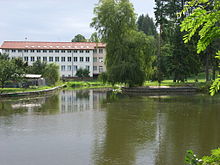world.wikisort.org - Czech
Sezimovo Ústí (Czech pronunciation: [ˈsɛzɪmovo ˈuːsciː]; German: Alttabor) is a town in Tábor District in the South Bohemian Region of the Czech Republic. It has about 7,200 inhabitants.
Sezimovo Ústí | |
|---|---|
Town | |
 General view from the west | |
 Flag  Coat of arms | |
 Sezimovo Ústí Location in the Czech Republic | |
| Coordinates: 49°23′7″N 14°41′4″E | |
| Country | |
| Region | South Bohemian |
| District | Tábor |
| First mentioned | 1250 |
| Government | |
| • Mayor | Martin Doležal |
| Area | |
| • Total | 8.44 km2 (3.26 sq mi) |
| Elevation | 399 m (1,309 ft) |
| Population (2021-01-01)[1] | |
| • Total | 7,176 |
| • Density | 850/km2 (2,200/sq mi) |
| Time zone | UTC+1 (CET) |
| • Summer (DST) | UTC+2 (CEST) |
| Postal code | 391 01 |
| Website | www |
Administrative parts
Sezimovo Ústí is formed by one administrative part.
Geography
Sezimovo Ústí is located approximately 83 kilometres (52 mi) south of Prague, and 60 kilometres (37 mi) north of České Budějovice. It is urbanistically fused with the neighbouring towns Tábor and Planá nad Lužnicí.
Sezimovo Ústí lies on the confluence of the Lužnice river, which makes the border of the municipal territory, and the Chotovínský Stream (also called Kozský in the length where it flows through the town). On the Chotovínský stream there is the fish pond called Jezero.
History

According to a legend, Sezimovo Ústí was founded by Sezima, an illegitimate son of Witiko of Prčice. The town was established in the first half of the 13th century. The first mention of Sezimovo Ústí is from 1250. The town prospered, which resulted from a convenient place on the way from Austria to Prague.[2]
In 1414, Jan Hus was invited to Sezimovo Ústí to preach in Kozí hrádek Castle, which led the radicalization of many people and establishment of Hussite movement. In 1420, Hussites burned down the town and left to a nearby newly established town of Tábor.[2]
In 1828, the new town was founded and named Starý Tábor ("Old Tábor"). In 1920, it returned to its historical name of Sezimovo Ústí. In 1939, the entrepreneur Tomáš Baťa began building a new district of Sezimovo Ústí, nowadays called Sezimovo Ústí 2. Baťa built a factory as well as accommodation and infrastructure for his employees at the factory.[2]
Sport
The main sport clubs in Sezimovo Ústí are TJ Spartak MAS and TJ Sokol Sezimovo Ústí. Sezimovo Ústí has one swimming pool.
Sights

Kozí hrádek is a castle ruin near Sezimovo Ústí, known for activities of Jan Hus. It is unknown when it was built, but it was first mentioned in 1377. It was built in Gothic style. In 1438, it was burnt down. The castle is a national cultural heritage site and nowadays the ruins are accessible.[3]
The villa of Czechoslovak president Edvard Beneš in Sezimovo Ústí was his favourite place of recreation, and the site of his burial. The villa and its garden is open to the public. There is also the monument with an exposition of political and social life of E. Beneš and his wife.[4]
The Church of Exaltation of the Holy Cross was built in 1841 in the late Empire style. In the park near the town hall there is a stone baptismal font and few stone fragments as the only remains from the original town which stood here until 1420.[2]
Notable people
- Jan Hus (1371–1415), theologian, philosopher and reformer; preached here
- Edvard Beneš (1884–1948), politician, President of Czechoslovakia; died here
- Václav Kaplický (1895–1982) writer, journalist and epic poet
International relations
Sezimovo Ústí is a part of the Commonwealth of towns with hussite past and tradition, along with other 11 Czech and 6 German municipalities.[5]
Twin towns – sister cities
Sezimovo Ústí is twinned with:[6]
 Thierachern, Switzerland
Thierachern, Switzerland
References
- "Population of Municipalities – 1 January 2021". Czech Statistical Office. 2021-04-30.
- "Sezimovo Ústí" (in Czech). Město Sezimovo Ústí. Retrieved 2021-09-13.
- "Historie" (in Czech). Kozí hrádek. Retrieved 2021-09-12.
- "Památník dr. Edvarda Beneše, prezidenta republiky" (in Czech). Hussite Museum in Tábor. Retrieved 2021-09-12.
- "Města" (in Czech). Společenství měst s husitskou minulostí a tradicí. Retrieved 2020-08-24.
- "Spolupráce měst" (in Czech). Město Sezimovo Ústí. Retrieved 2021-09-13.
External links
| Wikimedia Commons has media related to Sezimovo Ústí. |
Другой контент может иметь иную лицензию. Перед использованием материалов сайта WikiSort.org внимательно изучите правила лицензирования конкретных элементов наполнения сайта.
WikiSort.org - проект по пересортировке и дополнению контента Википедии
